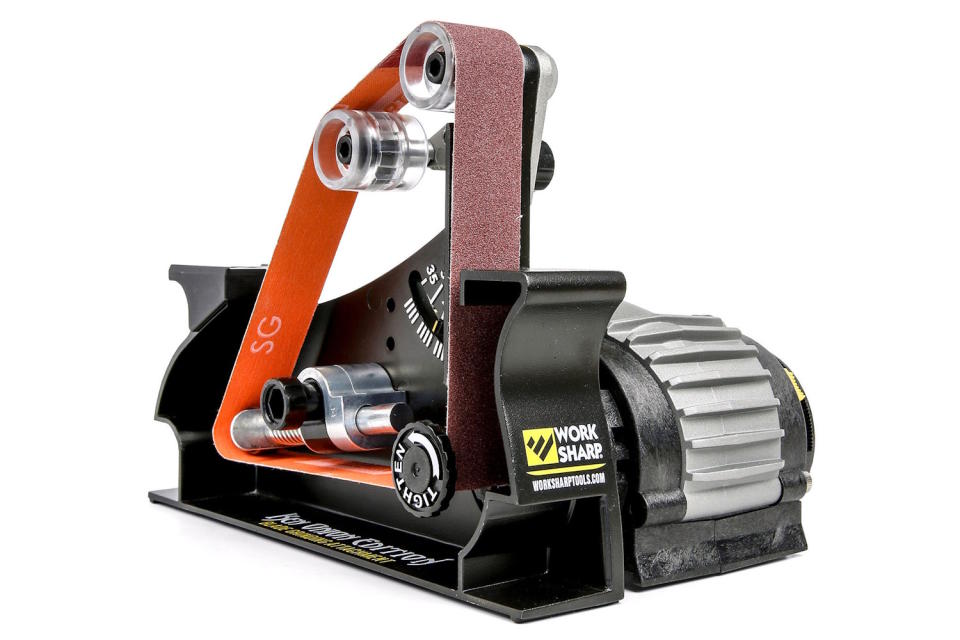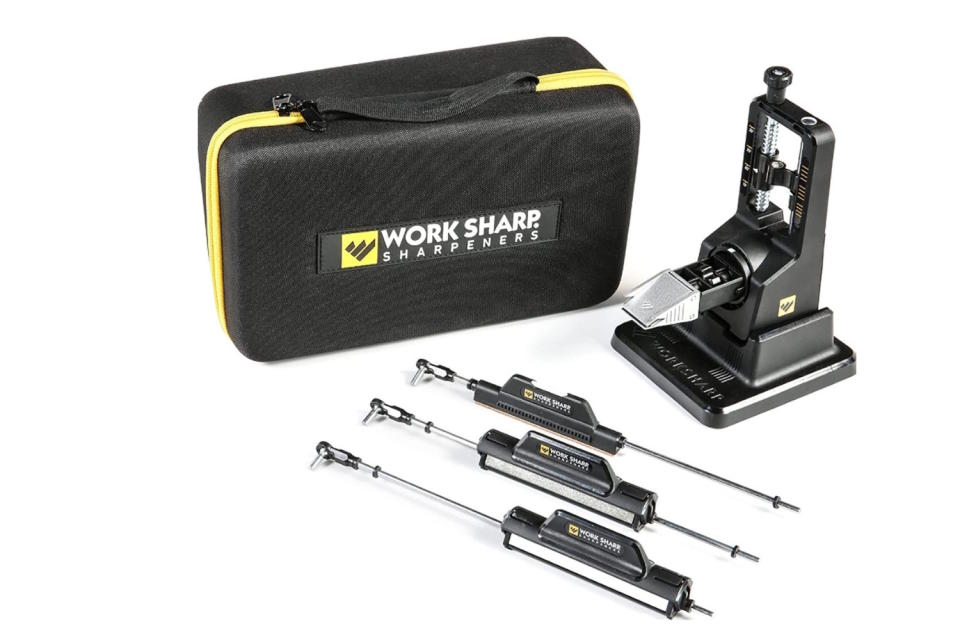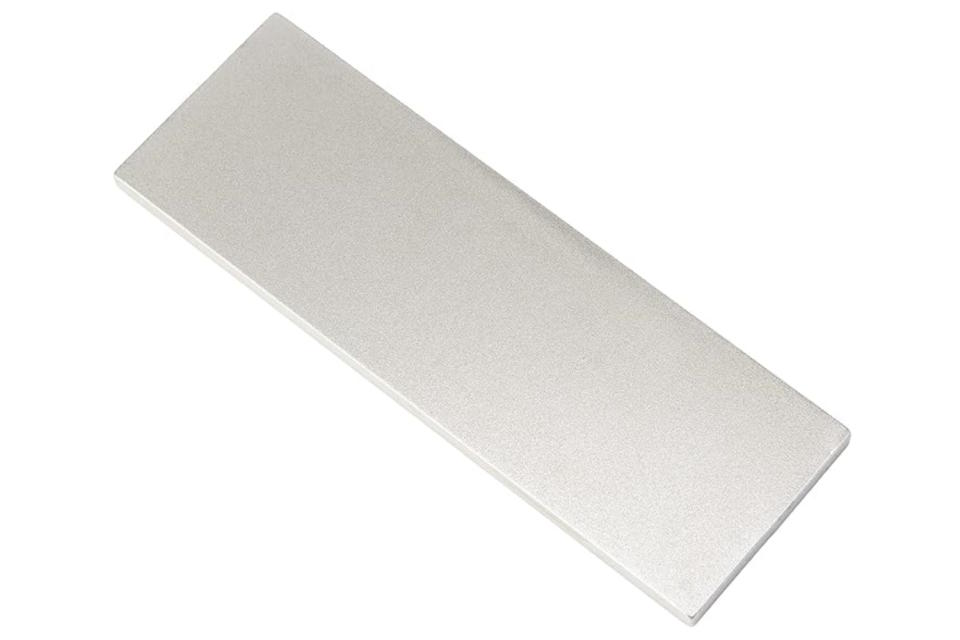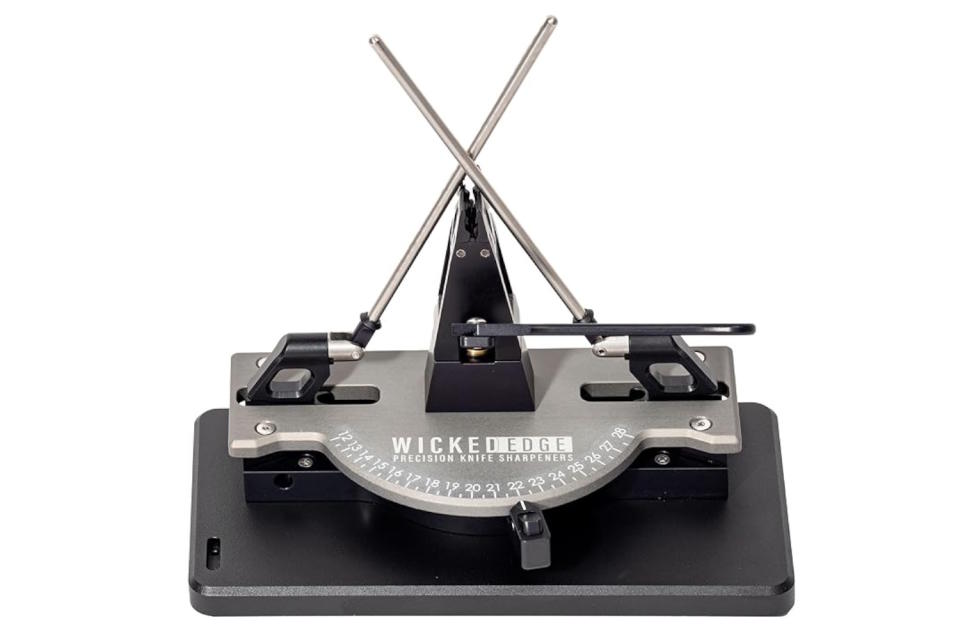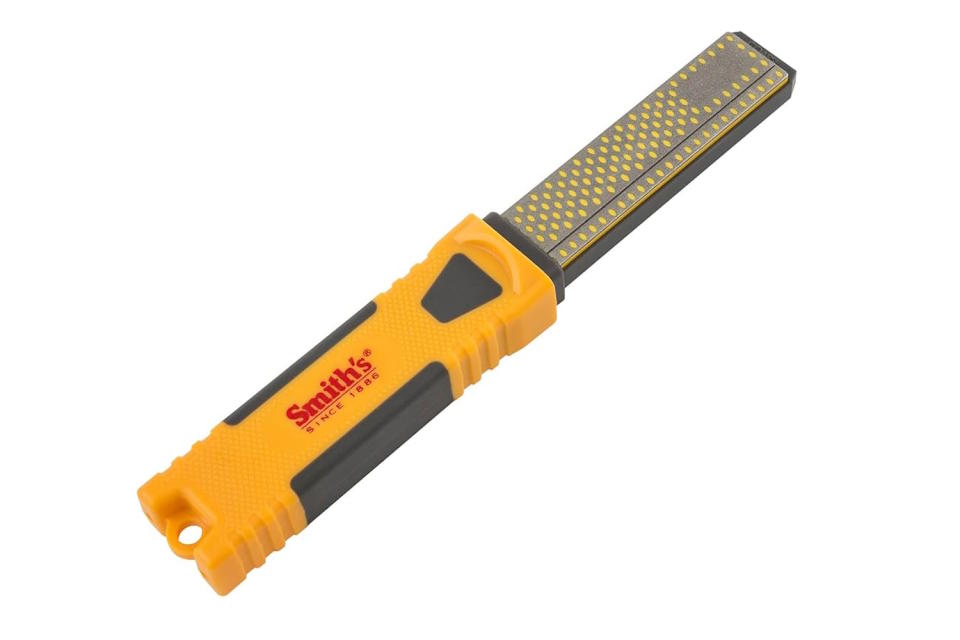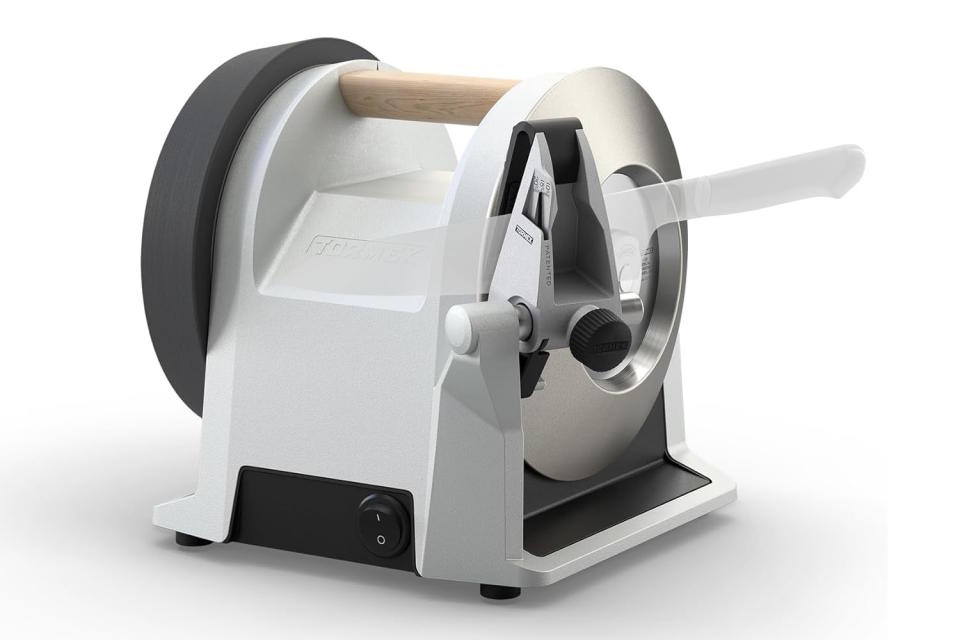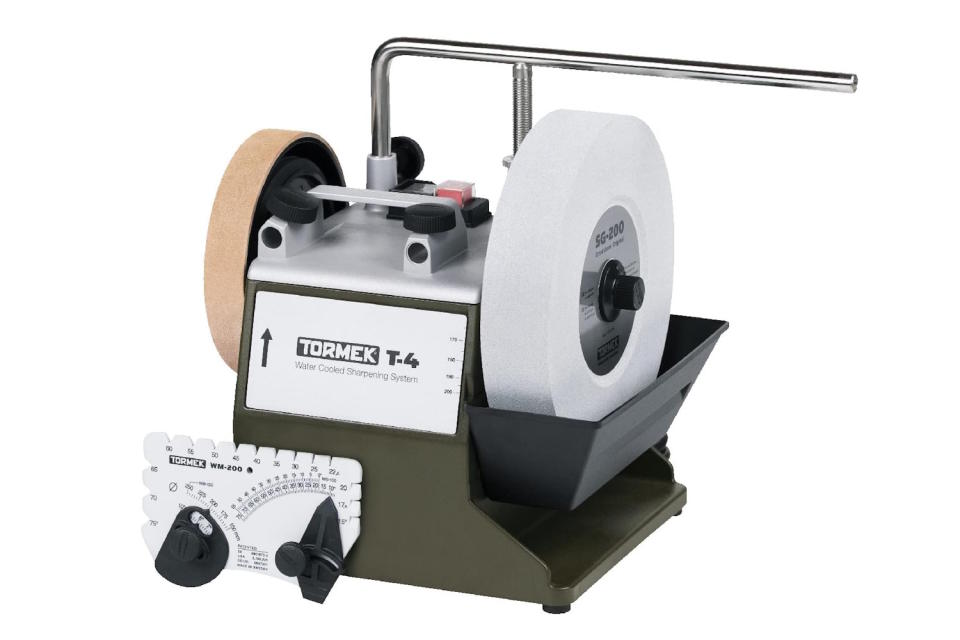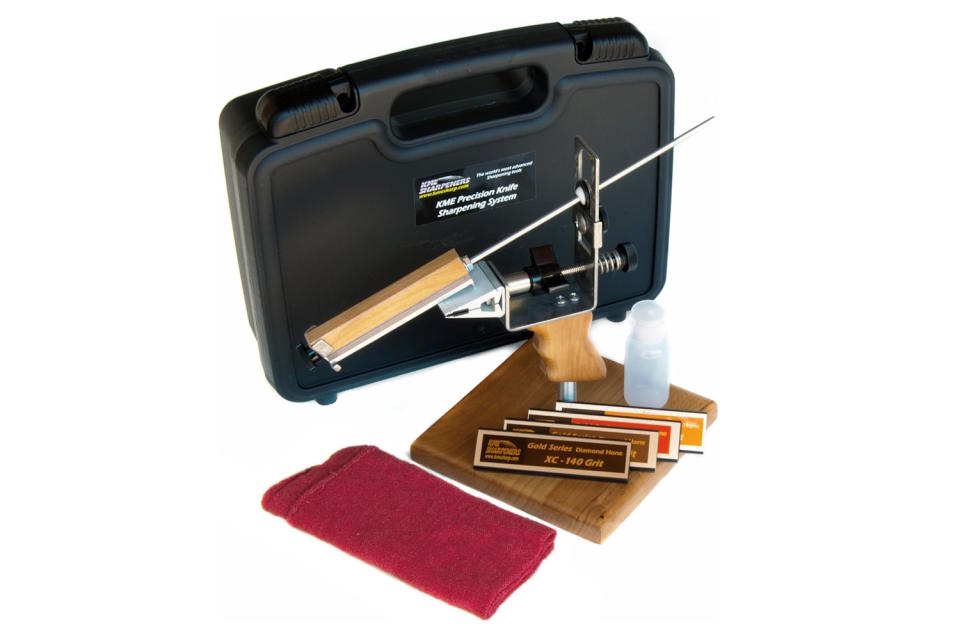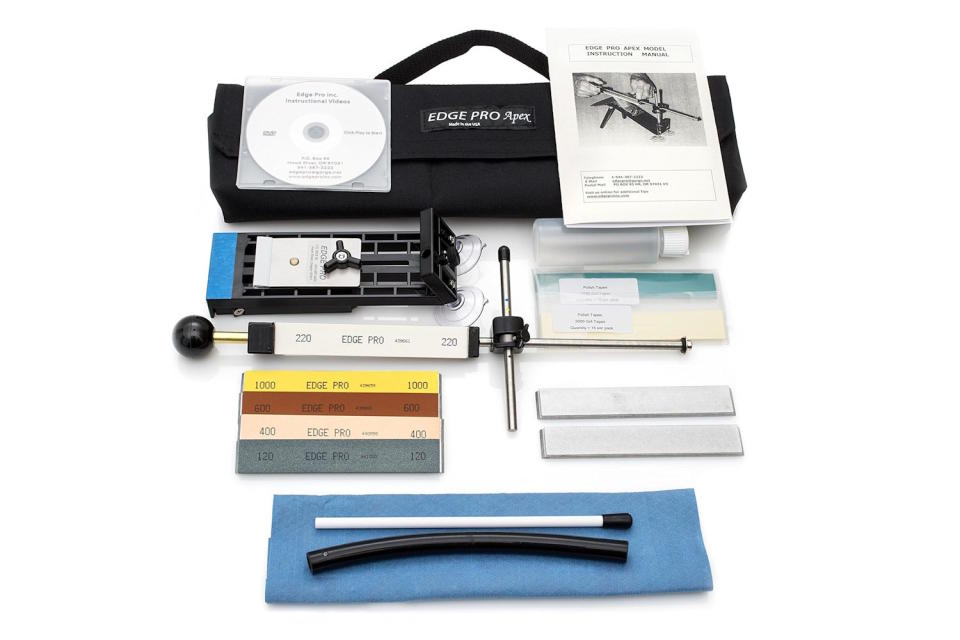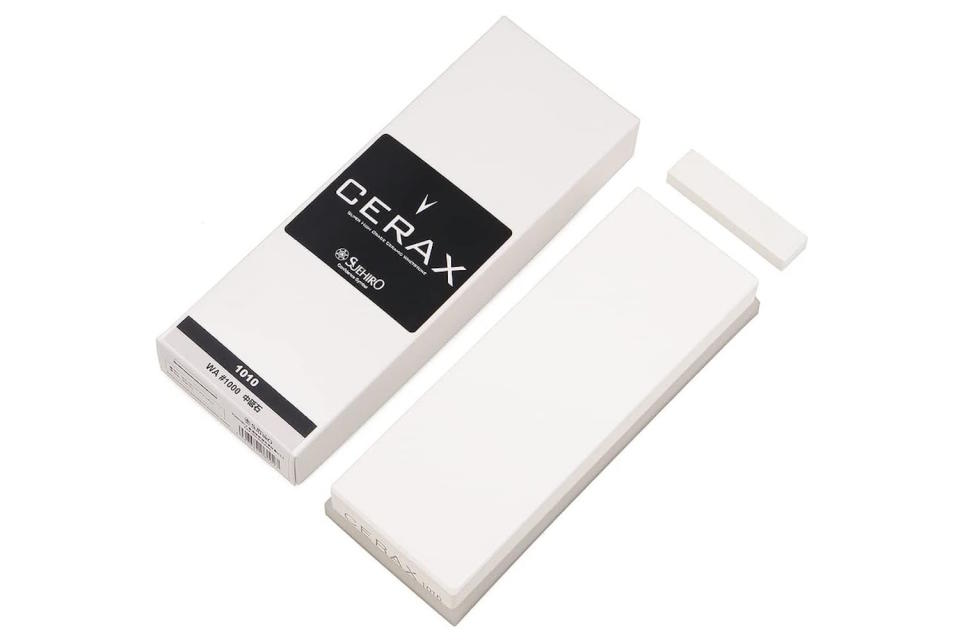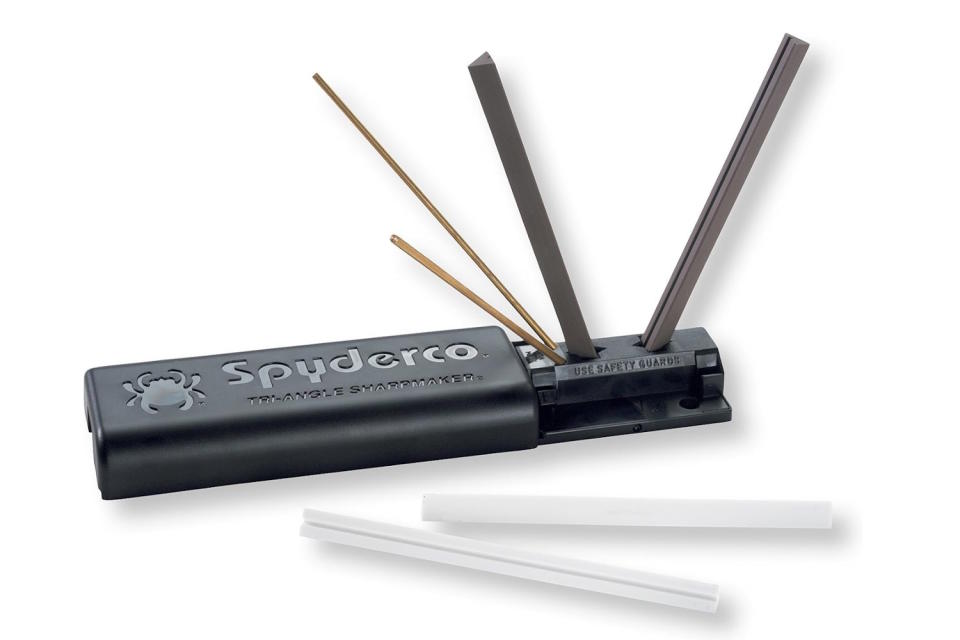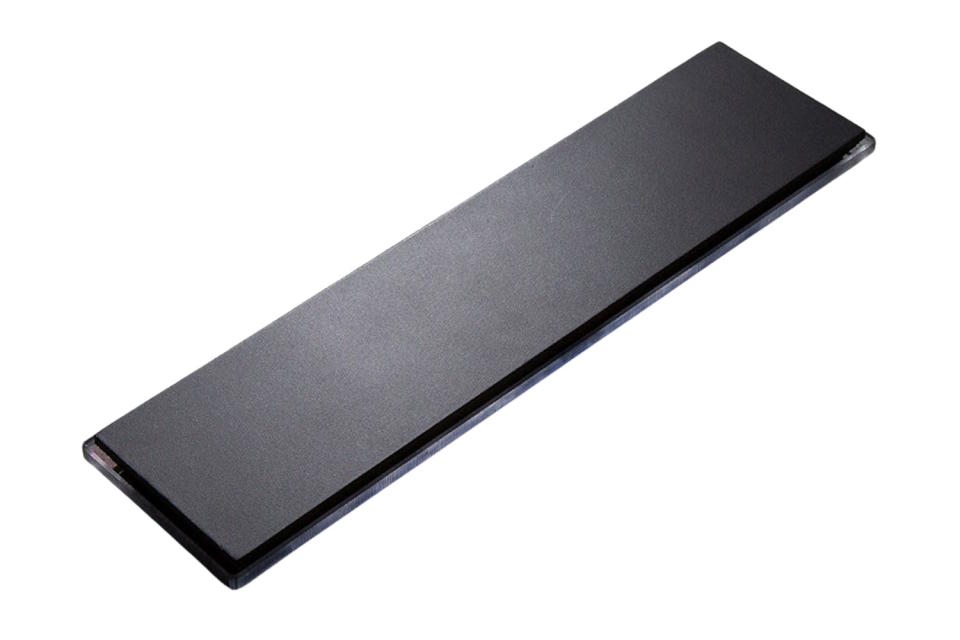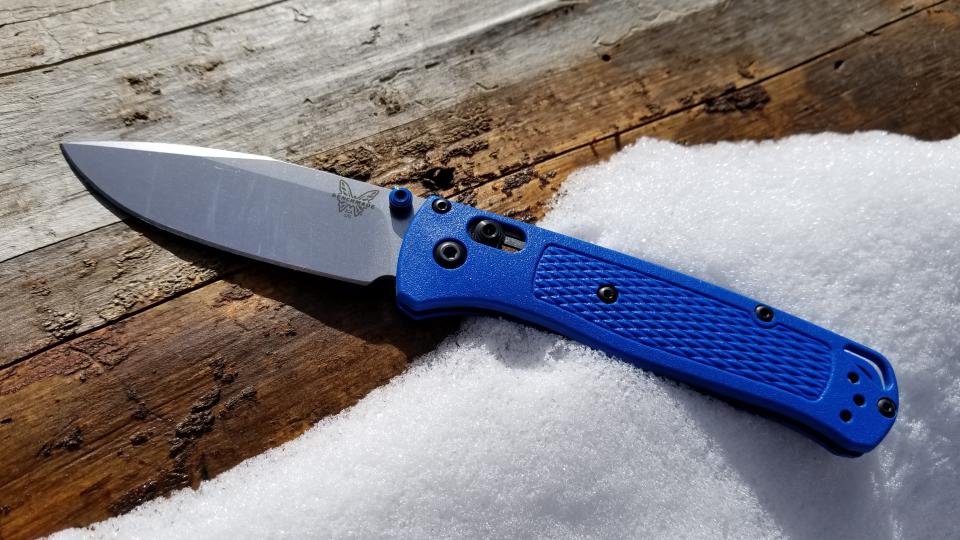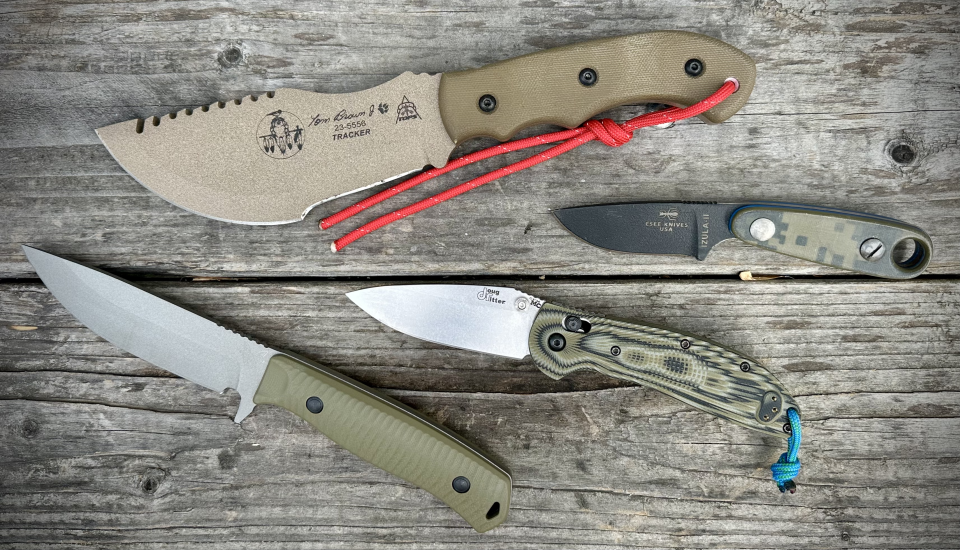The Best Knife Sharpeners of 2024
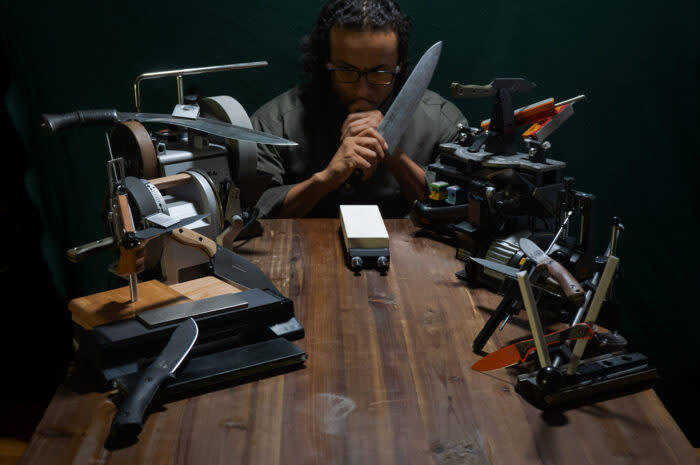
- Oops!Something went wrong.Please try again later.
Not all edges are sharpened equally, but all neglected edges are pretty equally useless. A folding saw that can’t cut firewood, a hatchet that can’t split sticks, and a filet knife that can’t prep the dinner you want to toss on the fire don’t just make for cold, tiring, and hungry night — they’re ample opportunities to cut yourself.
So, we tasked our edge obsessives — the sorts who always regrind every factory edge to get them just right — to round up the best sharpening systems on the market. Led by lead tester Ian Graber-Stiehl, a professional blade sharpener, we tested each system against just about every blade you could come across: budget folders, chisels, professional cutlery, high-end EDC steels, axes, machetes, shears, horse clippers, saws — you name it.
We used the systems here in kitchens, in the field, and at the workshop, to see not only what they sharpen best, but where they’re best suited. After all, the field sharpener an angler uses for shore lunch touch-ups isn’t ideal for sharpening knives at a farmer’s market for a few bucks — and a belt grinder that can quickly repair trail crew axes, probably wouldn’t be appreciated by the apartment neighbors of a line cook looking to retouch the kitchen’s knives after their shift.
The result: We’ve compiled a list of not only the best of the best sharpening systems, but the edges they excel with and where — and a buyer’s guide at the end for everything you need to know to take your bevels to the next level. If sharpening knives is new to you, consult our FAQ and comparison chart sections.
The Best Knife Sharpeners of 2024
Best Overall Knife Sharpener: Work Sharp Elite Knife Sharpening Solution
Best Budget Knife Sharpener: Work Sharp Precision Adjust Elite
Best Travel Knife Sharpener: DMT 6″ Double Sided Dia-Sharp Diamond Stone
Best Professional Knife Sharpener: Wicked Edge Generation 4 Pro
Best Field Sharpener: Smith’s Diamond Combination Sharpener
Best Kitchen Sharpener: Tormek T-1 Kitchen Knife Sharpener
Most Versatile Sharpener: Tormek T-4 Bushcraft
Best Overall Knife Sharpener
Work Sharp Elite Knife Sharpening Solution
Specs
Sharpener Type Electric belt sharpening system
Angle Range 10-35 degrees per side
Grits 120, 220, 1000, 3000, 12,000
Size 10 x 6.5 x 6”
Best For Traditional knives, landscaping and trail tools
Skill Level 2 out of 5
Pros
Quick grinding
Incredibly versatile
Wide angle selection range
Easy to operate
Freehand and guided sharpening modes
Easily convexes edges
Cons
Loud
Messy/dusty
Requires replacement belts
Can overheat edges
The Work Sharp Elite Knife Sharpening Solution ($200) is a mouthful. However, for our money, this pairing of Work Sharp’s widely-loved Ken Onion Edition motor with a semi-freehand 1 x 18” belt sharpening system also boasts the greatest compromise between versatility, ease of use, and bang for your buck for hobbyists, home users, and pros alike.
The main grinding area can be set at any edge between 10-35 degrees (per side). Simply hold the side of a blade against the flat shelf for a horizontal reference first, then grind. A flat, vertical secondary grinding area can also be used for completely freehand grinding — or even for sharpening saw teeth on the edges of belts.
The Solution does come with some tradeoffs. It naturally produces convex edges, though using stiff belts, positioning the rollers close, or freehanding it along the secondary vertical grinding area can get you a flatter grind. It also isn’t completely ambidextrous. Sharpening the right side of blades is a touch more cumbersome. Moreover, it’s only as consistent as your hand is steady.
Belt sharpening systems also mean that sharpening will always require buying new belts — especially high-grit ones, which wear faster. At high grits and high speeds, and with too-slow passes, friction can also overheat and damage the tips of blades. Most importantly, belts kick out steel dust, meaning a mask is a must-have for lengthy operations.
Nevertheless, the Solution’s flexibility is unparalleled. It’s small enough to carry anywhere you might need it. On high, even badly damaged blades can be brought from chipped messes to mirror polishes faster than with any other system on this list. From heavy-duty tools like lawnmower blades, convex axe edges, difficult geometries like recurve blades, or super acute edges — you’d be hard-pressed to find an edge the Work Sharp Elite Knife Sharpening Solution can’t keep well beyond working sharp.
Pro Tip: Get an aftermarket leather stropping belt or two, and some stropping compound. They’ll touch up edges without running through belts or kicking up dust.
Check price at Worksharp Tools
Best Budget Knife Sharpener
Work Sharp Precision Adjust Elite
Specs
Sharpener Type Clamping, manual, angle-guided
Angle Range 15-30 degrees per side
Grits 220, 320, 400, 600, 800 grit diamond, ceramic plate, ceramic rod, compound-loaded strop
Size 11.5 x 4.5 x 7” case
Best For EDC blades, cutlery under 9”
Skill Level 1 out of 5
Pros
Budget-friendly
Takes up little space
Easy to operate
Rubberized clamp prevents scratching
Swiveling clamp
Good grit progression
Cons
Limited low-angle options
Angles not always accurate
Struggles with large, thick blades
Clamp flexes without support
Slow at reprofiling blades
Work Sharp’s Precision Adjust Elite Kit ($140) is a fantastic option for those focused on bang for their buck, portability, and straightforwardness. Its clamp rotates with ease to sharpen either side of a blade. The stones integrate into a rotating housing, allowing them to stow and swap easily. The Precision Adjust’s angle setting system allows for minute adjustments, making matching the angle of any blade a breeze.
The Elite Kit expands on a sensible grit progression system capable of quickly taking even extremely dull, high-hardness steels like S90V from dull to plenty sharp and relatively polished. And, at only a half-inch wide, the stones also easily sharpen recurved edges — a tricky blade profile to maintain.
However, high in precision, the Adjust is a touch lower in accuracy. Like many clamp-based systems, the actual sharpening angle depends on the blade’s height and can vary significantly from the labeled angle settings. So, reprofiling — regrinding an edge to a different angle — calls for an angle-finder cube (like the one that comes with the Precision’s Big Brother).
We also found that reprofiling with the Precision Adjust is a slow affair. While the diamond stones make sharpening a breeze, their small size and relatively high starting grit aren’t the best for heavy regrinding.
Our biggest pet peeve was the clamp’s tendency to flex under pressure, changing the sharpening angle. However, this is easily solved with anything wedged between the clamp and the base to prevent flexing.
Overall, most of our nitpicks were only relevant on the margins: with heavy blades that made the system want to tip, or when completely reprofiling super hard steels. For people simply looking to keep their EDCs and cutlery razor sharp with a system that is easy to use, quick to stow, and won’t break the bank, the Work Sharp Precision Adjust Elite Kit is a fantastically conscientious pick.
Pro tip: The Elite includes an arm with a ceramic rod to knock the burr off an edge. Be sure to kick the angle setting a few degrees high so it hits the very apex of the edge.
check price at blade hqcheck price at scheels
Best Travel Knife Sharpener
DMT 6″ Double Sided Dia-Sharp Diamond Stone
Specs
Sharpener Type Diamond bench stone
Angle Range N/A
Grits Fine/Extra Fine, Coarse/Extra Coarse
Size 2 x 6”
Best For EDC blades, cutlery, woodworking tools
Skill Level 3 out of 5
Pros
Fast-cutting abrasive
Compact
Versatile
Less care required than oil or whetstones
Good for higher-end, high-carbide steels
Cons
Can rust if stored wet
Grits somewhat coarse for rating
Leave a heavy scratch pattern on edge
DMT’s Dia-Sharp Stones, especially the double-sided 6-inch versions, (starting at $55) are the king when it comes to quick, quality, compact, cost-effective freehand sharpening. Two stones, the Extra Coarse/Coarse and the Fine/Extra Fine, especially combined with DMT’s Magna Base Holder, can sharpen anything you can while taking up all of the space of a 1.5L bottle.
Like any diamond stone, they do remove material aggressively. Likewise, what DMT considers “Extra-fine” is still a bit coarse for a finishing stone, in our minds. The company does offer an Extra-Extra-Fine finishing stone, but only single-sided, and not in smaller sizes. So, the Dia-Sharps may be overkill for light touch-ups. They also leave a pretty aggressive scratch pattern on edges, need to be dried completely before long-term storage to prevent rust, and are only as capable as your freehand technique is good.
However, the Dia-Sharps punch well above their weight class, especially for EDC-ers and woodworkers. Modern medium- and high-end EDC blades are typically high in alloy components and harder than the abrasives traditionally used to sharpen blades. Many whetstones need to be soaked before use and leveled every so often.
These Diamond stones never require leveling or soaking, and can quickly remove material from even the hardest modern steels. Since not every company’s “grits” are the same size, DMT’s forthrightness about how many microns a given grit is extremely useful.
Simply put, if you need to quickly put a razor’s edge on just about any cutting tool (other than maybe a recurve blade), in just about steel, while carrying little, the DMT Dia-Sharp Stones are a premier pick. Hence, they were the go-to workplace sharpener for one of our testers through years of tending bars where coworkers chipped blades every shift.
Pro tip: The 6 x 2″ stones were our pick, but you don’t have to stick with one size. DMT’s Magna Base kit can easily accommodate just about any size diamond stone.
$53 at Amazoncheck price at blade HQ
Best Professional Knife Sharpener
Wicked Edge Generation 4 Pro
Specs
Sharpener Type Manual, double-sided, clamped, angle-guided
Angle Range 12-28 degrees per side; 12-33 with Micro-Adjust
Grits 100/200, 400/600, 800/1000
Size 7 x 11 x 11.5”
Best For Professional-level knife sharpening
Skill Level 2 out of 5
Pros
Ease of use
Consistency
Range of accessories
Integrated storage options
Build quality
Cons
Stock vice only accommodates blades under 5 mm thick
Expensive
Accessories required for acute and mirror-polished edges
There is a good reason why the Wicked Edge Gen 4 Pro ($1,000) is at the top of the wishlist of every EDC fanatic and pro sharpener we know: It makes getting incredibly sharp and consistent edges a breeze at a professional pace — with accessories.
The backbone of the Gen 4 is a double-sided diamond-based abrasive system that allows for easy adjustment of both sides. Simply clamp a blade in, match the angle (made especially easy with the micro-adjustor) or set a new one, and get to grinding with both hands — for a price.
The Gen 4’s biggest downside is that its high price is the starting point, not the end. Even without the micro-adjust and storage shelf (which aren’t strictly necessary), the limited accommodations of the vice, the inherent variability of a clamp system, and the quality you’d have to turn out to justify the price, make additional accessories necessary.
Acute, especially asymmetrically-ground Japanese chef’s knives will call for a Low Angle Adapter. Blades over 3/16″ thick will require alternative jaws, which even then, tap out shy of extremely meaty blades like traditional khukuris. Reprofiling blades and mirror-polishing blades for discerning customers will call for a digital angle finder and a suite of extra stones.
The tradeoff here is simple: For the vast and overwhelming array of blades that people pay to have sharpened, chef’s knives, EDC blades, hunters, filet knives — even that one Christmas gift ceramic santoku that’s been rattling around dull in a drawer for a decade — there isn’t a more consistent, user-friendly system for getting amazing edges. Not to mention… the Wicked Edge Gen 4 Pro is just sexy.
Pro tip: Clamp systems tend to leave a steeper edge angle near the tips of curved blades. With the Gen 4, it’s a breeze to reposition a blade in the clamp so the belly of a blade will sit at the same height, and be ground at the same angle, as the rest of the knife.
$999 at Amazoncheck price at wicked edge
Best Field Sharpener
Smith’s Diamond Combination Sharpener
Specs
Sharpener Type Handheld diamond field sharpener
Angle Range N/A
Grits 325/750 grit Coarse/Fine
Size 4 x 2 x 1”
Best For In the field touch-ups
Skill Level 1 out of 5
Pros
Lightweight
Portable
Versatile
Integrated hook sharpener
Cons
No reference angles
Finishing grit relatively coarse
Smith’s Diamond Combo Sharpener ($20) has had a place in our pockets for over 10 years for good reason: It’s simple and it works. Yes, there are field sharpeners with more bells and whistles. Work Sharp’s Guided Field Sharpener, for example, comes with two diamond plates, multiple ceramic rods, an angle guide, strop, and a broadhead wrench. It also comes with a higher price tag and more weight.
There are smaller and lighter field sharpeners, like the glut of pocket pull-through sharpeners all over the market. But rarely do they put on as good of an edge. For a field sharpener, a stowable and streamlined capability is the name of the game. Fittingly, the Smith’s Diamond Combo handle can sheath the diamond plates. This protects the abrasives and your pack alike while providing a slim, packable, weather-resistant profile.
We also found the handle ergonomic, putting distance between your hands and edges, while making field sharpening easy. Likewise, the grits of the diamond plates are more than enough to put a working edge on just about any blade.
The Smith’s Diamond Combo is exactly what a field sharpener should be: cheap, easy to pack, hard to break, and effective on everything from hunting knives and broadheads to fishing hooks and multitools.
Pro Tip: Short sectional strokes along a blade, followed by a few passes on the fine grit at a slightly steeper angle make it a breeze to deburr and micro bevel an edge — giving you a keen edge in no time.
$20 at Amazoncheck price at blade hq
Best Kitchen Sharpener
Tormek T-1 Kitchen Knife Sharpener
Specs
Sharpener Type Electric, rotary, pull-through
Angle Range 8-22 degrees per side
Grits 600 grit diamond, composite hone
Size 8 x 6.5 x 7”
Best For Kitchen cutlery
Skill Level 1 out of 5
Pros
Quick
Incredibly quiet
Simple
Wide angle range
Cons
Large profile for a kitchen sharpener
No alternative grit wheels
Easy to round out blade tips and heels
There is no shortage of pull-through sharpeners marketed for kitchen knives, but the Tormek T-1 ($371) is the best we’ve ever used. The vast majority of kitchen-oriented sharpeners are manual pull-through carbide stones that often damage edges. Electric pull-throughs can get an edge relatively sharp, but typically offer little variability in angle range and mediocre permanence.
The Tormek T-1 is another beast entirely. Its 600-grit stones made short work of restoring even relatively damaged edges. The 8-22 degree range makes it easy to match the edge angle of almost any style of cutlery. The felt and magnet thoughtfully integrated into the clamp made it easy to ensure that blades didn’t get scratched while drawing them through.
We did find it to be slow at completely reprofiling edges — something that would be helped by Tormek offering a wider range of replaceable wheels. Although incredibly simple to use, a slow hand can also easily round out the tip or heel of a knife over time.
The T-1 also sits at a niche nexus. It can sharpen most blades, but is best in a kitchen. It’s large for a home kitchen sharpener, but a bit limited for professional kitchens.
However, between a whisper-quiet motor, an integrated handle, and a frankly gorgeous design, the Tormek T-1 wouldn’t be out of place on any countertop. With a wide angle range, an effective abrasive system, and the ability to accommodate everything from the smallest paring knife to the largest bone cleaver, the T-1 is a premier pick for passionate chefs — both home and line cooks alike.
Pro tip: While the T-1’s clamp is great for most blades, especially flexible ones like filet knives, removing it allows the T-1 to easily accommodate tall cleavers.
$378 at Amazoncheck price at tormek
Most Versatile Sharpener
Tormek T-4 Bushcraft
Specs
Sharpener Type Electric, water-cooled grinder/rotary strop
Angle Range Nearly all of them
Grits 220 and leather honing wheel
Size 11 x 10.5 x 10.5”
Best For Pro-grade sharpening
Skill Level 5 out of 5
Pros
Unmatched versatility
Fast, professional sharpening and reprofiling
Wide angle range
Quiet and clean
Cons
Large
Expensive
Relatively high skill level needed
Not best for convex edges
You’d be hard-pressed to find a cutting tool the Tormek T-4 Bushcraft ($590) can’t put a professional-quality edge on. Throughout our testing, the only edge it couldn’t tackle were saws, hair clippers, and the meaty convexed recurves of khukuris. For everything else, the T-4 is a premier pick.
At its core, the T-4 Bushcraft is a rotary, water-cooled whetstone grinder/leather strop combo with jigs for knives and axes alike, which can match or regrind nearly any edge, to nearly any angle: chisels, pocketknives, cutlery, woodturning equipment, pizza cutters, even tungsten carbide and ceramic blades — with the right equipment.
The T-4 easily hangs with our heavy hitters. With the right setup, it can grind edges just as consistent and sharp as the Wicked Edge Gen 4, in less time, and with more range. It loses out on size, utility for thick convexed tools like axes, and (without diamond stones) speed against the Work Sharp Elite Knife Sharpening Solution — but is far quieter, cleaner, more precise, and can’t overheat an edge.
The Tormek T-4 has a pro-quality jig and a stone for almost every type of tool. The downsides: It’s by far the most complicated system to set up and use here, and those accessories add up. After extra stones and jigs, it’s not hard for the T-4 system to blow past the Gen 4’s high price tag.
The tradeoff? The ability to get incredible results on almost any type of blade. So much so that our sharpening guru Ian Graber-Steihl said that if he could only have one guided system for sharpening everything, both client’s tools and his own alike, it’d be the T-4. After all, if a Tormek can’t sharpen it, you’d probably have to do it by hand anyway.
Pro tip: While Tormek offers tools for setting the angle, combining a measuring tool like this one with a grinding wheel calculator, or using a diamond wheel with a jig that allows you to grind on the side of a wheel makes angle-setting leagues easier.
Best of the Rest
KME Precision Knife Sharpening System Deluxe Kit
Specs
Sharpener Type Manual, clamping, angle-guided system
Angle Range 17-30 degrees per side
Grits 50, 60, 100, 120, 140, 300, 320, 600, 1500
Size 1 x 4” stones
Best For Travel-friendly jack of all trades
Skill Level 2 out of 5
Pros
Compact size
Quick grinding
Easy operation
Extensive grit range
Modular
Cons
Limited angle range
Angles inaccurate without angle finder
KME, especially its Precision Knife Sharpening System Deluxe Kit ($335), doesn’t excel in any one thing — but certainly earns top marks in almost everything. It’s among the smallest, quickest, most portable, easiest to use, and well-built systems in our lineup.
All KME kits come with a case for easy transport and storage. Between the build quality and swiveling stand, once set up, it offers the slickest, best-feeling operation of any manual system we’ve tested.
KME’s stones are among the smallest we’ve tested, but punch well above their weight class. The 50-grit “Beast” diamond plate included in the Deluxe Kit is particularly aptly named. The coarsest stock stone of any kit we’ve used, it makes heavy grinding leagues quicker than any other system in the lineup. Even the 100-grit coarse diamond plate included in the brand’s more cost-wise R.P.S.H. Combo Kit is a speedy beast in its own right.
Our biggest complaints were just the limited angle range and kit options. As with any clamping system, the actual grinding angle depends on the height of the blade, but the 17-30 degree range trends steep for acute cutlery. Likewise, without any micro-adjustment system, dialing in the angle can be a bit finicky.
The Deluxe is also the only kit that includes a suite of diamond stones and a base. Others, like the R.P.S.H. Combo, lack the base, as well as the fastest-cutting and highest-polishing stones.
Even so, any KME kit, especially the Deluxe, is excellent. Its portability, speed, and ability to be used sans base make them practical for travel sharpening (perfect for those who end up sharpening familial knives during the holidays). KME’s extensive accessories, from axehead sharpeners and convexing kits to mirror-polishing strops, also allow any of its kits to be expanded into a truly impressive system.
Edge Pro Apex 4 Kit
Specs
Sharpener Type Manual angle-guided system
Angle Range 10-27 degrees per side
Grits 120, 220, 400, 600, 1000, and 1200 ceramic hone
Size 1 x 6” stones
Best For Large knives and mirror-polished edges
Skill Level 3 out of 5
Pros
Extensive angle range
Accurate angle settings
Quality polishing stones
Good for large blades
Numerous accessories
Cons
Not the most stable base
Easy to scratch blades
Long guide arms makes storage difficult
Less consistent with certain blade grinds
Of all the systems we’ve tested, none are as good at sharpening as consistently or to as high a finish, right out of the box, as the Edge Pro Apex 4 Kit ($285). Unlike most of the other manual systems here, the Apex isn’t a clamp-based design — which, without a careful hand, changes the sharpening angle slightly as you run along the curve of blades.
Instead, the Apex allows you to set and slide the blade along a table. This means that the sharpening angle doesn’t change with the height of the blade either — usually eliminating the need for an angle measurer. On the downside, it can be more difficult to account for the angle at which full flat-ground blades, or those with only small flat portions, rest on the table.
The Edge Pro also offers some of the largest and finest grit stones of any angle-guided system on the market. This makes it, for our money, the easiest system for those obsessed with fine, mirror-polished edges. The tradeoff is that even the coarsest of the stock stones reprofile hard steels slowly, and themselves wear relatively quickly.
The guide arm also doesn’t have any micro-adjustment for angle-setting, and the suction cup base doesn’t like to adhere to every surface — making the Apex finicky to set up without some accessories like the bench mount. Without some prep, it’s easy to scratch up the finish of knives as you draw them along the table, since steel particulates tend to collect there.
However, the Edge Pro Apex 4 Kit is an OG. Offering arguably more in-house and aftermarket accessories and stones than any platform we’ve tested, the Apex can be expanded into one of the most economical pro-grade manual knife sharpeners on the market — some experience, time, and assembly required.
$285 at AmazonCheck Price at Blade HQ
Suehiro CERAX 1010
Specs
Sharpener Type Ceramic soaking whetstone
Angle Range N/A
Grits 1000
Size 3 x 8.25”
Best For Everything — with a steady hand
Skill Level 4 out of 5
Pros
Quick cutting
Larger than average
Slow to load with swarf
High feedback
Higher than average polish
Cons
Requires pre-sharpening soak
Chips easily
There are far faster and more consistent overengineered options in 2024, but few compare to the streamlined versatility of a good whetstone. A good freehand sharpening session is one of the most spiritual experiences a knife obsessive can have — second only to your significant other finding the bill for the last knife you bought. And few whetstones provide a better quality experience than the cost-conscious Suehiro CERAX 1010 ($33).
Much of freehand sharpening comes down to feedback and hardness. Whetstones with more softly bonded particulates typically form an abrasive slurry more quickly but require longer soaking times before use. Harder stones offer better feedback and shorter soak times but clog with swarf more quickly.
Suehiro consistently manages to hit a sweet spot, with its CERAX 1010 being a standout. It wears somewhat quickly, but cuts fast for a medium grit stone, offers tons of feedback on edge orientation, and doesn’t clog with swarf easily.
The CERAX 1010 is slow for badly damaged edges and ultra-hard high-carbide steels, but for simply livening up dull edges, it’s so much of a dream to work with that we genuinely lament that our edges rarely get dull enough to break it out.
For a complete freehand sharpening system the Suehiro 5/6-Piece Sharpening Kit offered by Burrfection bundles two of our favorite whetstones, the CERAX 1010 and Rika 5000, into one fantastic package.
Spyderco Tri-Angle Sharpmaker
Specs
Sharpener Type Angled rod sharpening
Angle Range 15 or 20 degrees per side
Grits Medium/Fine combo
Size 1.5 x 8 x 3” packed
Best For Quick touchups and micro-beveling
Skill Level 2 out of 5
Pros
Extensive angle range
Accurate angle settings
Quality polishing stones
Good for large blades
Numerous accessories
Cons
Not the most stable base
Easy to scratch blades
Long guide arms makes storage difficult
Less consistent with certain blade grinds
Spyderco’s Tri-Angle Sharpmaker ($127) is the touch-up king. It is simplicity at its finest, with a pair of medium and fine stones that can be set at 15 or 20 degrees per side, a horizontal mounting option for shallower angles, and the ability to stow the entire system into itself.
Aside from quick touch-ups, there is another place where the Sharpmaker shines the most: micro beveling. This practice of taking a few swipes at a slightly steeper angle than the edge was sharpened is a great way to knock the burr off an edge and bring it back to hair-popping sharp.
A precision system this is not. If you’re looking to put a perfect mirror polish on an edge or restore a chipped blade, the Sharpmaker isn’t the move. Reprofiling an edge with the Sharpmaker goes beyond an exercise in patience.
However, the Spyderco Sharpmaker is ideal for regular maintenance and serrated blade sharpening. With the optional diamond stones, we found it quick and easy to touch up even relatively dull, high-carbide steels like S90V and CPM-20CV without having to break out the big toys and whetstones.
$81 at AmazonCheck price at Blade HQ
Burrfection Rolled Buffalo Premium Leather Strop
Specs
Sharpener Type Compressed leather strop
Angle Range N/A
Grits Buffalo hide
Size 10 x 0.75 x 2.75” packed
Best For Regular maintenance
Skill Level 1 out of 5
Pros
Gorgeous
Naturally abrasive
Easily loads with compounds
Perfectly flat
Integrated base
Cons
Pricey for a strop
Large for a strop
Hot take: As vital as stones are, a good strop is vital for maintaining a blade. With one of our testers having gone months keeping their favorite chef’s knife shaving sharp sans stones — we’ve found that few strops maintain an edge with the style, quality, and sharpness of Burrfection’s Rolled Buffalo Strop ($63).
Buffalo hide naturally tends to contain fewer silicate abrasives than some high-end horsehair hides. However, compression concentrates these abrasives on the surface. This, combined with the toughness of Buffalo hide and how easy it is to load with stropping compounds, make Burrfection’s compressed buffalo strop our unequivocal favorite.
It comes perfectly flat with rubberized feet to prevent slipping. Burrfection offers three base options: polycarbonate (our waterproof, budget-conscious favorite), tempered glass, and Hinoki wood. Every one of them makes for a gorgeous and utilitarian addition to any kitchen counter — exactly where we keep ours, at the ready.
Knife Sharpeners Comparison Chart
Knife Sharpener | Price | Type | Angle Range | Best For | Skill Level |
|---|---|---|---|---|---|
$200 | Electric belt sharpening system | 10-35 degrees per side | Traditional knives, landscaping and trail tools | 2/5 | |
$140 | Clamping, manual, angle-guided | 15-30 degrees per side | EDC blades, cutlery under 9” | 1/5 | |
$55 | Diamond bench stone | N/A | EDC blades, cutlery, woodworking tools | 3/5 | |
$1,000 | Manual, double-sided, clamped, angle-guided | 12-28 degrees per side; 12-33 with Micro-Adjust | Professional-level knife sharpening | 2/5 | |
$20 | Handheld diamond field sharpener | N/A | In the field touch-ups | 1/5 | |
$371 | Electric, rotary, pull-through | 8-22 degrees per side | Kitchen cutlery | 1/5 | |
$590 | Electric, water-cooled grinder/rotary strop | Nearly all of them | Pro-grade sharpening | 5/5 | |
$335 | Manual, clamping, angle-guided system | 17-30 degrees per side | Travel-friendly jack of all trades | 2/5 | |
$285 | Manual angle-guided system | 10-27 degrees per side | Large knives and mirror-polished edges | 3/5 | |
$33 | Ceramic soaking whetstone | N/A | Everything — with a steady hand | 4/5 | |
$127 | Angled rod sharpening | 15 or 20 degrees per side | Quick touchups and micro-beveling | 2/5 | |
$63 | Compressed leather strop | N/A | Regular maintenance | 1/5 |
How We Tested Knife Sharpeners
Our lead tester, Ian Graber-Stiehl, is an edge obsessive. He’s a “knife guy” through and through, who definitely doesn’t have a problem and can quit collecting anytime he wants. As a former bartender, cook, and hobbyist bladesmith, he’s lectured many coworkers about metallurgy and nearly strangled more than a few for chipping his santoku knife by tossing it in the sink.
Moreover, he’s professionally sharpened blades for commercial kitchens, antique axe and sword collectors, sushi chefs, home cooks, hairdressers, horse trainers, woodworkers, and more — and never met a factory edge he didn’t completely reprofile within weeks.
When it comes to sharpening, the biggest factor differentiating one steel from another is carbides: structures formed by the combination of carbon with various alloying elements. There are various types of carbides, but all of them, like stones embedded in a glacier, are much harder than the surrounding steel.
Some carbides, like vanadium and niobium, are harder even than most abrasive compounds typically used to sharpen knives — save for diamonds and cubic boron nitride (CBN).
To get a good idea of how various sharpening systems performed in the real world, we tested each system against steels in three brackets. To approximate the maintenance of softer, lower carbide steels often used in bushcraft blades, axes, budget EDC blades, and mid-range cutlery, we used each system to sharpen steels like 1050, 1095, 14C28N, and AUS10.
The biggest range of testing was with the medium-high carbide content steels common to mid-to-high-end cutlery, fixed blades, and folders like S35VN, CPM-154, and M4. Lastly, to see how well each system held up to the hardest high-end EDC blades, we also used each sharpener with stubborn steels like S90V and S110V. A few diamond-base systems were also tested against ceramic knives.
Buyer’s Guide: How to Choose a Knife Sharpener
Beyond Simple Sharpening
Not every blade is a knife, nor is every sharpening job simple. On a long enough timeline, every blade gets chewed up, chipped, and spit out. Our testers have used many of these systems for years, but newcomers and old ones were all put through a diverse wringer.
The most consistent backbone of our head-to-head tests were Benchmade’s Station and Table Knives, whose edges we dragged (with a heavy heart) along bricks until they were chipped, dull, and damaged. The CPM-154 steel, edge geometry, and the latter’s partial serrations made them an excellent analog for how each sharpener would handle heavy restoration and reprofiling of a broad spectrum of steels.
We also tested tool-oriented systems like the T-4 and Work Sharp Elite Knife Sharpening Solution by reprofiling axes, machetes, and khukuris. Systems capable of sharpening up saw teeth were put to task by touching up folding saws. Ultimately, every testee was thrown up against a broad array of different tools, edge geometries, and degrees of dullness.
Sharpening Science
There are many approaches to sharpening, but the principles are all the same. How coarse a grit you should start at depends. (Pro tip: Different companies and types of abrasives have different grit sizes, but if a company offers the size of the abrasive particles in its stones in microns, this is a universal unit.)
The more material you need to remove, the coarser you should start. For simple sharpening, coloring in the edge of a blade with a black marker makes it easy to ensure you’re matching the existing edge angle.
As you grind one side of a blade, you will form a burr: a thin, wiry piece of steel at the edge that folds over to the other side. A burr, especially with coarse stones, is easy to feel with your fingers or even see with the naked eye.
Form a burr on one side, then sharpen the other side until you form a burr in the other direction. Then move up in grit and repeat, sharpening each side until you form a burr and replacing the scratch pattern of the previous stone with the current, finer stone.
After stopping at your desired grit, all that’s left is to break off that burr, to reveal a fresh edge. This can be done in several ways: with hones, strops, or with a stone. Simply run the blade backward (think: the opposite direction of how you’d cut) at a slightly steeper angle on alternating sides until you break the burr off. Deburring, realigning warped edges, and light touch-ups are where hones and strops truly excel.
Factory Settings
Edges aren’t created in a vacuum. Their geometry is a compromise between doing a job as well as possible, and working for as many users as possible.
Many pocket knives and Western kitchen knives, for example, are simply V-ground to around 20-odd degrees on each side, with the steel left relatively thick behind the edge. This makes for an edge that will cut well enough, and be a bit harder for less careful users to chip and damage.
How an edge comes from the factory does not necessarily determine its best performance. The same blade that works well for one person left thick behind the edge with a steep angle might work better for another at a thinner and more acute angle.
Geometry Matters
Likewise, there are many different edge styles. The ones most divergent in sharpening experience are arguably convex, V-ground, micro-beveled, and asymmetric edges.
V-grinds are the easiest to manufacture and resharpen consistently. Pick an angle, stick to it, and grind. On the downside, V-grinds have a shoulder — a sharp transition from the edge to the rest of the blade above, which has more resistance in the cut. They can also be harder for new sharpeners to freehand, especially in the field.
A V-grind with a few swipes taken on a fine stone at a steeper angle, to hit the very apex of the edge, simplifies things. For most resharpenings, only this “micro-bevel” at the very apex needs attention, speeding up touch-ups. On the downside, this makes for a steeper edge.
Asymmetric edges come in two flavors. On the extreme end, a chisel-ground edge is sharpened only on one side. The wide edge provides plenty of feedback when resharpening but steers your cuts in one direction.
More common, especially among Japanese cutlery, are edges that are sharpened at different angles on either side. These edges are often extremely acute and cut well. However, they can make sharpening more difficult — especially on angle-guided systems, where sharpening each side requires completely changing settings.
Convex edges (think apple seed-shaped) allow for a steep angle at the apex, for a tougher edge, with a rounded shoulder for slicker cuts. This makes it much easier for them to be sharpened freehand. The tradeoff: sharpening on more angle-guided systems is considerably harder.
Different Strokes for Different Steels
Most steels tend to be relatively soft and easy to resharpen on almost any kind of stone, oil, and water. With these sorts of steels, the biggest hurdles are often repairing damaged edges — especially for thick blades like axes, hatchets, bushcraft knives, and khukuris.
Thick blade stock means sharpening requires removing more material. So, reprofiling an edge and repairing large chips can still be a slow affair.
High-end EDC knives tend to trend towards steels that are chock full of carbides, which are harder than the abrasives in traditional whetstones and oil stones. This allows them to hold an edge for ages. However, this can make sharpening (especially reprofiling) these steels an exercise in tedium.
As a general rule, if the name of the steel in a blade starts with “CPM” or “ZDP” — doing the bulk of your sharpening with either a diamond abrasive or powered grinder is a good way to make life easier. We recommend reading up on the specific steel your blades are made from, as it will pay off during sharpening.
Types of Sharpeners
Ultimately, what type of sharpeners will work best for you is determined by a mix of what you’re sharpening, how much you’re sharpening, where you’re working, how skilled you are, and what your budget is.
The best sharpener for a home cook on a budget isn’t the best for professionally sharpening ultra-hard steels, nor is it ideal for a landscaper repairing damaged mower blades, nor is it the most neighbor-considerate option for apartment-bound bartender touching up the kitchen knives at home at 3 a.m.
Even so, what’s more important isn’t the method. It’s the edge at the end. After all, an edge that cuts reliably is less likely to cut you.
Sandpaper
On the simplest end of the scale is sandpaper. For hand-sharpening your average steels, most sandpapers will work — though silicon carbide or ceramic sandpapers tend to perform the best.
Clamping sheets of sandpaper to a table is actually how our lead tester cut his teeth. The downside is that sandpaper is only as flat as the countertop you clamp it to. This actually makes sandpaper ideal for convex edges, since it can be clamped to a flexible backing like a mousepad. Likewise, for a budget, lightweight field sharpener, you can wrap a strip of sandpaper around a block eraser for touch-ups.
However, sharpening with sandpaper can involve a fiddly setup, and quite a bit of time, especially with harder steels. Likewise, being consumable, it’s usually more expensive in the long run than a good set of stones.
Bench Stones
There are many types of sharpening stones, but they traditionally come in two broad categories: oil and whetstones. The abrasives in these stones — usually novaculite, silicon carbide, or aluminum oxide — can overlap quite a bit. The distinction is in how the abrasive particles are bound together, how you use them, and how fast they cut.
The abrasives in oil (or Arkansas) stones are bound tightly into a hard stone. This means they wear slowly, and don’t need much maintenance. They’re also fantastic for polishing.
However, a stone’s wear exposes fresh abrasives. So, less wear makes for slower sharpening, especially with very high-hardness steels. Oil stones also clog more easily with steel particles or ‘swarf’. Fortunately, when an oil stone gets really clogged and discolored, a few minutes of warm, soapy water and a scrubby pad will clean it right up.
The abrasive particles in whetstones are bound more loosely. This means the stones themselves wear more quickly and form an abrasive slurry. This makes for faster sharpening. However, most whetstones must be soaked in water before use and leveled more often than oil stones to stay flat — typically with either a diamond plate or a leveling stone.
Plates embedded with diamond or cubic boron nitride (CBN) are less traditional but incredibly fast. Boasting, respectively, the world’s first or second hardest abrasives; these plates sharpen quickly, require minimal maintenance, and stay perfectly flat.
On the downside, diamond and CBN bench stones are often expensive, provide less feedback than traditional stones, and can be heavy-handed for lighter sharpening — removing more material than needed and leaving heavy scratches on the edge.
Manual Angle-Guided Sharpeners
These incorporate any of the above abrasives into a system that secures the blade, allows you to dial in the angle, and uses a guide arm that holds a stone to sharpen at a consistent angle.
There are broadly two types of manual angle-guided systems. Clamp-based ones like the KME, Wicked Edge, and Work Sharp Precision Adjust Elite secure a blade in a clamp that can rotate to hit both sides of a blade. This makes them simple and easy to use.
However, the actual sharpening angle of these designs depends heavily on how far the edge protrudes from the clamp. Likewise, the point of contact, and thus the sharpening angle, will change on heavily curved parts of a blade. So, for precision obsessives, an angle-measuring cube of some type may be necessary.
Table systems, like the Edge Pro, require holding a blade on an integrated table, with the edge hanging off. Because the blade’s position can be manipulated, even with long and heavily curved blades, it’s much easier to keep a consistent angle.
On the downside, these systems are a bit more involved to operate. You also need to account for the angle at which blades with no flat sides will rest — still making an angle cube a good idea. Swarf can also easily get on the table, scratching a blade’s finish as it’s drawn along.
Electric Sharpeners
There’s no shortage of electric sharpeners. However, the best of them generally fall into two categories: belt systems and grinding stones.
Belt sharpeners are the quick-grinding kings, but speed comes with costs. They’re noisy. Consumable belts are a secondary cost. And even with belt sharpeners marketed for kitchen use, we at GearJunkie recommend using a face mask to keep from inhaling steel dust if you’re grinding at low grits or for more than a few minutes at a time indoors.
At high speeds and high grits — especially on a belt with stiff backing — friction (particularly at the tip) can overheat a blade. Dunking a blade in water helps, but it can be messy and time-consuming, and (for folding knives) it can get rust-prone swarf in the pivot without cleaning.
Systems like the Work Sharp Elite and MK.2 scale down the power and speed of a grinder. With more slack, the chances of the belt overheating a blade are lower — though that slack means that you’ll get slightly more of a convex edge. Adjustable angle guides make sharpening more precise and easier. That said, the dust and noise remain.
On the other end of the scale are powered grindstones. Although there are some systems like the Tormek T-1, which are meant to be used dry, the majority of grinding systems meant to be used for sharpening are water-cooled, like the Tormek T-4.
These are the behemoths of the list, and easily the most complex systems. Their grinding wheel — either a whetstone, CBN, or diamond-embedded wheel — rotates through a water trough. They remove material incredibly fast. Running at low speed, they make little noise. With the stones constantly covered in a film of water, you’ll never overheat the blade, and the swarf collects neatly in the trough.
Wet grinding systems are endlessly customizable, with jigs for every occasion. However, unless you’re either sharpening professionally or working with tools that need to be sharpened regularly (landscaping, woodworking, cooking, etc.) it can be hard to justify the bulk and expense.
Home Kitchen Sharpeners
Kitchen sharpeners aren’t a class unto themselves. That said, keeping kitchen cutlery sharp comes with certain considerations.
Countertop space can come at a premium. A full suit of soaking whetstones or a large powered grinder of some sort can take up a lot of space. A belt sanding system could contaminate food around with steel dust.
On the upside, most kitchen cutlery steels are considerably softer than most EDC steels. Likewise, it’s easy to touch up kitchen knives on the regular.
Pull-through sharpeners are very popular for kitchen use because of their size and ease. However, we at GearJunkie don’t recommend most of them. Most pull-through sharpeners use thin blades of tungsten carbide oriented in a v-shape to scrape material from a blade.
Aside from limitations like being slow for heavy sharpening, a limited ability to change the angle, and how easy it is to be inconsistent when drawing a blade through, these carbide sharpeners can damage blade edges.
Carbide blades are brittle. Steel, like wood, has a grain. Grinding both sides of an edge while scraping off the burr, by drawing steel along the grain, against a brittle material, and putting pressure on a very thin cross-section of the edge at a time, is an easy way to chew it up.
Electric pull-through systems that sharpen one side at a time using a belt (like the Work Sharp Elite) or a grinding wheel (like the Tormek T-1) are much better and faster. They also allow you to adjust the sharpening angle.
As long as you’re not cutting with a straight edge on glass or ceramic plates or cutting board (an activity that both frustrates and keeps professional sharpeners employed), which is just about the quickest way to chip and dull an edge, most of the time kitchen knives will only need quick touch-ups to realign the edge.
A steel honing rod or strop works really well for realigning and polishing. Ceramic hones or strops rubbed with a sharpening compound remove more material, making them better for light sharpening as well.
Price
Most sharpeners tend to break down pretty neatly into a few different price brackets. On the ultra-budget end of the scale are the DIY solutions that run a few bucks: sandpaper clamped to a mousepad or a homemade strop of leather glued to a 2×4.
The $15-35 range is where you typically find touch-up tools like quality strops, hones, and pull-through sharpeners.
Bench stones, especially when comparing oil, whet, and diamond stones, can range quite a bit. However, the vast majority fall into the $30-100 range. For home and hobbyist sharpeners, stones, and strops in this range will offer the greatest versatility and bang for your buck of any offering.
From $140 to $350 is where most precision sharpeners fall: angle-guided system kits (most manual clamp or table-centric systems, and some powered). These typically come with a suite of different grit abrasives. The manufacturing companies also typically offer numerous optional attachments for different types of blades.
Equipment in this range is typically much faster and more precise than freehand sharpening. With experience and accessories, these systems can be expanded into nearly pro-grade kits.
At the $400-1,500 end of the scale, we get into pro-grade systems that are capable of precision, versatility, and exceptional speed. Gear like the Wicked Edge Gen 4 Pro, the Tormek T-4 (and its bigger brother the T-8), or full-on belt grinders, can speedily regrind dozens of blades in a day. However, the expense is hard to justify for non-pros — be they professionals at sharpening, or in fields that involve working with a lot of harp tools, such as trail builders, chefs, woodworkers, landscapers, and more.
FAQ
What is one of the best knife sharpeners?
What’s best is heavily situational. For our pick, the Work Sharp Elite Knife Sharpening Solution is a versatility-minded tool that can handle almost everything you throw at it, with a modicum of precaution.
Otherwise, for simple, cost-wise versatility, little can beat a good whetstone like the Suehiro CERAX 1010.
What do professionals use to sharpen knives?
Professionals usually have a number of pieces of equipment that excel at different things. However, they largely fall into three categories:
Manual, angle-guided systems like the Wicked Edge Gen 4 Pro are often used to achieve precision, mirror-polished edges, especially on smaller blades.
For heavier sharpening water-cooled grinding wheel systems like the Tormek T-4 and T-8, and belt grinders (bladesmithing grinders at the extreme end and systems like the Work Sharp Elite Knife Sharpening Solution for smaller jobs) are common choices.
Lastly, good, old-fashioned whetstones still have their place, especially for extremely acute or asymmetric edges, such as those found on Japanese chef’s knives.
What really makes a professional job is understanding what type of edge a given blade requires, and how to use the tools available to get it done.
Are pull-through sharpeners bad for knives?
Pull-through sharpeners that use a carbide blade to sharpen both sides of a knife at the same time can damage edges very easily. Electric pull-through systems that sharpen one side at a time with a belt or grinding wheel, on the other hand, such as the Work Sharp Ken Onion or Tormek T-1, can be fantastic.
Can you sharpen a knife too often?
Sharpening often won’t damage an edge. However, sharpening inherently requires removing material. Doing so too often and with too heavy a hand will eventually grind the edge of a blade higher and higher up, towards the thicker spine of the blade. This leaves it thicker and less slicy behind the edge.
An easy workaround is to regularly touch up a blade with a ceramic hone or a strop loaded with compound. Regular maintenance with light-handed tools can make it so that a blade rarely has to touch anything beyond relatively fine stones.
What happens if you never sharpen a knife?
In all likelihood, you cut yourself. A dull blade doesn’t just make a task harder, it makes it more dangerous. Not to mention, knowing how to sharpen a blade is a timeless skill.
The Best Knives for Hiking & Backpacking of 2024
Hikers want a light, reliable, versatile pocket knife on the trail. These nine knives will keep hikers happy mile after mile.
The Best Survival Knives of 2024
GearJunkie knows a thing or two about knives. We’ve sorted through dozens of blades to bring you the best survival knives of 2024.
The post The Best Knife Sharpeners of 2024 appeared first on GearJunkie.
